|
Home Page
Glen Echo
The Town
Chautauqua
Amusement Park
• Post Cards
• Souvenirs
• Tickets
• Early Programs
Modern Times
History Book
Cabin John
The Town
The Hotel
Amusement Park
The Bridge
Legends
History Book
Great Falls
Post Cards
Other Stuff
Conduit Road
The Trolleys
Buildings
The Aqueduct
The Road
General
Capital Transit Passes
Historic item Trader
Minnie Brooke Postcards
|
Buildings along Conduit Road
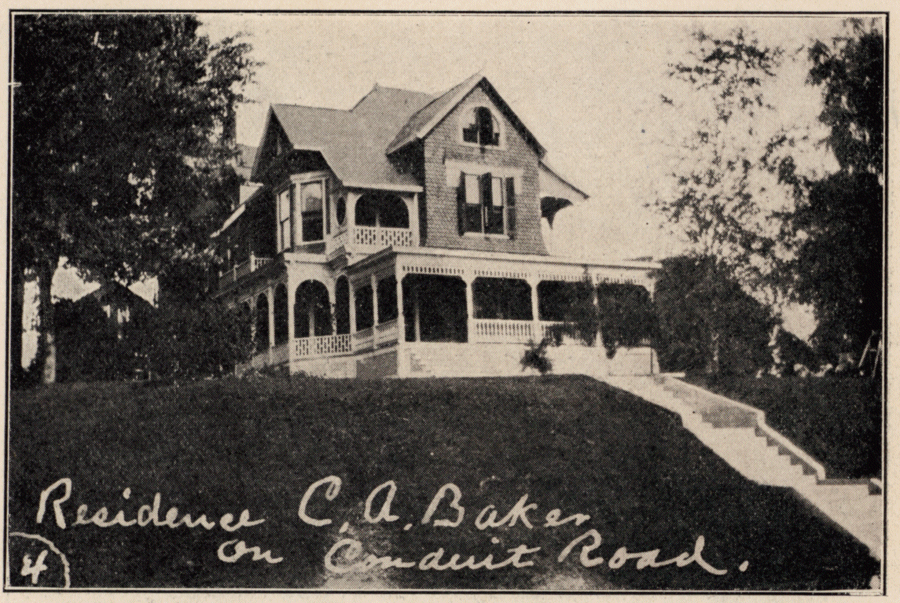
Private residence within Washington DC on the Counduit Road, ca 1912
Buildings along Conduit Road
Conduit Road was built by the Army Corp of Engineers to provide access for maintainence of the Washington Aqueduct which runs beneath it. As the Aqueduct provided nearly all of the city's clean water it was critical that problems could be resolved quickly, thus it made sense that the road surface needed to be very well maintained.
The 'Conduit' itself is the main pipeline of the aqueduct; a 9 foot diameter round tunnel built of multiple layers of brick, set in morter. This conduit gave the road its original name.

The Rock Spring Club seen approcahing from the city, stables can be seen in the background, ca 1897
Buildings along Conduit Road
Its being the best maintained road in the area, it quickly became a favorite route for weekend carriage rides, and by the 1880's it saw the beginnings of construction of homes along the road.
The first structures aslong the road were those of built by the Corp of Engineers to support the aqueduct, some of which can be seen on the aqueduct page.
The earliest homes along the road were built within the limits of Washington DC. Most of these were large stone homes in the victorian style. The next structures built were private clubs, road houses and restaruants.

Looking back toward the city at the Rock Spring Club, ca 1897
Buildings along Conduit Road
One of the largest private clubs was the 'Rock Spring Club', it was built below the low bluffs along Conduit Road between the DC line and Walhonding Road
The sale of alcohol was declared illegal in Montgomery County, Maryland in 1881, though the law was little enforced for many years.
Private clubs were created to give the illusion of a 'Club' where members had exclusive rights of entrance, but were often little more than enormous bars. These clubs thrived between 1881 and around 1910.
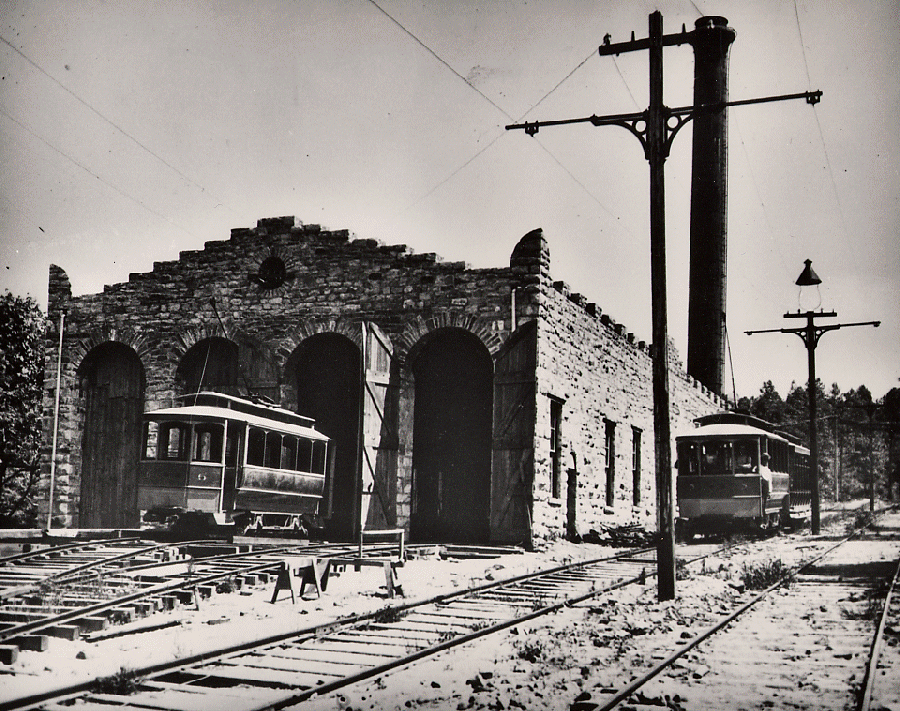
The Glen Echo Electric Railroad carbarn and power house, ca 1897
Buildings along Conduit Road
Moving farther out from the city along the road, the next structures were those of the Glen Echo Electric Railroad built by the Baltzley Brothers who also built the Glen Echo Chautauqua.
Built in 1891, the power house and trolley barn for the railroad sat about 100 yards up Walhonding Road within sight of Conduit Road. The car barn occupied the top floor of the structure, with the power system housed below.
The trolley line stopped near the car barn for the years between 1891 and 1896, when the tracks were extended over the Conduit Road and on to Glen Echo Park.
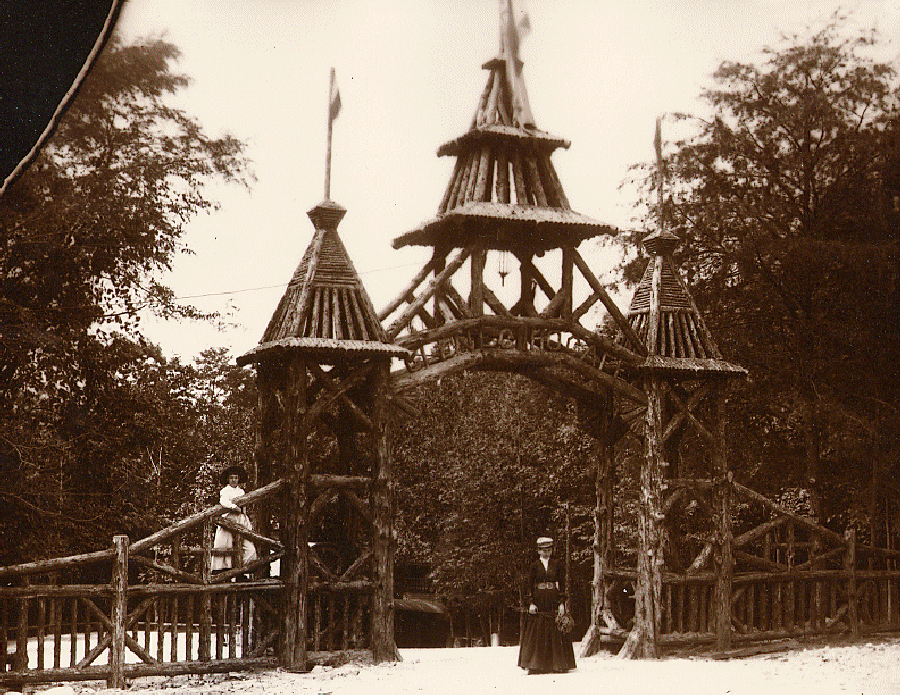
The entrance arch to the Glen Echo Cafe, ca 1890
Buildings along Conduit Road
Directly across Conduit Road from the car barn was the entrance arch to the Glen Echo Cafe. The cafe was named Pa-Tow-O-Meck, supposedly a more accurate rendition of the indian word for the nearby Potomac river. The cafe was built of 30,000 cedar trees harvested from all over the area around Glen Echo. Cedar trees remained rare in the area up until the 1960's, so extensive was the harvest.
Carriages drove through the cedar archway into the grounds of the cafe, then further to the entrance of the structure where a porte-cochere provided shelter for customers to disembark from their carriages. A short walk over a cedar bridge led to the entrance of the huge restaruant.
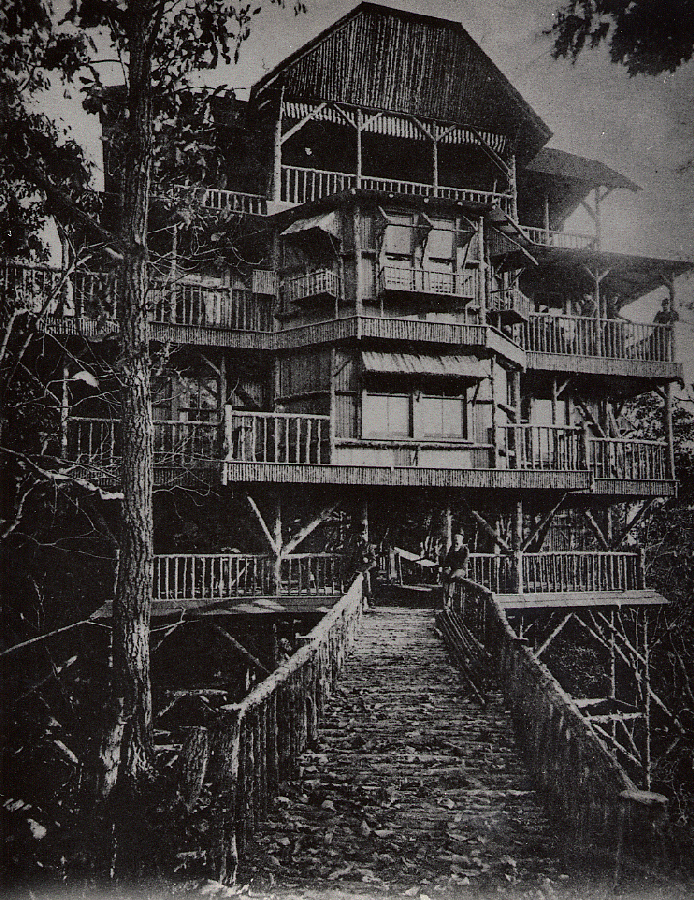
The side of the Glen Echo Cafe that faced the river. 1890
Buildings along Conduit Road
The trolley line was not finished when the cafe opened, but the Baltzleys would likely have had a carriage to take customers the short distance from the car barn.
While the structure of the cafe was rustic, the furnishings were anything but! They had crisp linen tablecloths, and fine lead crystal on the tables. The elite of Washington society came in droves to the new sensation of the dining world far out in the countryside outside the city.
The cafe did a brisk business for the few short months it was open. They opened in July of 1890 to rave reviews in the local newspapers, and were still filling the restaruant well into November in spite of the long ride in the cold weather.
Then on November 29th 1890, after only five moths in business, the cafe burned to the ground in the middle of the night. The balze lasted only two hours, but the entire cafe was gone!
Edwin Baltzley and his family were living in a cedar log cabin at the top of the three story cafe. When the fire broke out they were fast asleep.

The home of R. A. Charles, on the hills overlooking the Conduit Road in Glen Echo Heights (now Mohician Hills). 1891
Buildings along Conduit Road
By the time a cafe employee woke them fire has spread throughout the structure. Edwin and his wife carried their children out of the flaming building, escaping with literally ust the clothes on their backs.
The cafe was a complete loss. Edwin walked among the ruins two days later and found silverware twisted and fused together from the intense heat of the blaze. After a few days to regroup, the Baltzley brothers announced that they would rebuild the cafe 'IN STONE'.
Throughout the period of the cafe's success the Baltzleys were not resting on their laurels, they were activelt selling home sites in the areas now called Mohician Hills and Glen Echo Heights. The deeds stipulated that a substantial home had to be constructed on the site within a limited period.

Edward Baltzley's palatial home next to the Charles house, ca 1899
Buildings along Conduit Road
The brothers opened seven granite quarries, several of them in the glen echo area, and sold stone 'at the cost of quarrying' to the buyers of their lots. They would alos build homes for buyers if they wished.
Three substantial granite homes were soon in construction. Two of these sat on a high hill with an impressive view of the Potomac river. One was for a customer, R. A. Charles, who worked for the Treasury Department - where Edward Baltzley had worked for many years before the Glen Echo venture started. The other was built for Edward to live in and as a showpiece for their new suburban development.

Another view of the Baltzley house, ca 1910
Buildings along Conduit Road
Years later, around 1897, Edward would go west with his son Clarance to prospect for silver and gold. AT this point Edwin and his family moved into the house with his family.
In 1893, rumors of malaria at Glen Echo dried up lot sales. Though many lots had been sold, no new homes were being built. The Baltzley's dreams of a 'Washington Rhineland' crumbled. Over the following few decades many buyers defaulted on their deeds and no one wanted to build at Glen Echo Heights.
Edwin and his family left Glen Echo for good around 1904 after having lost his fortune trying to recover Glen Echo's glory days.
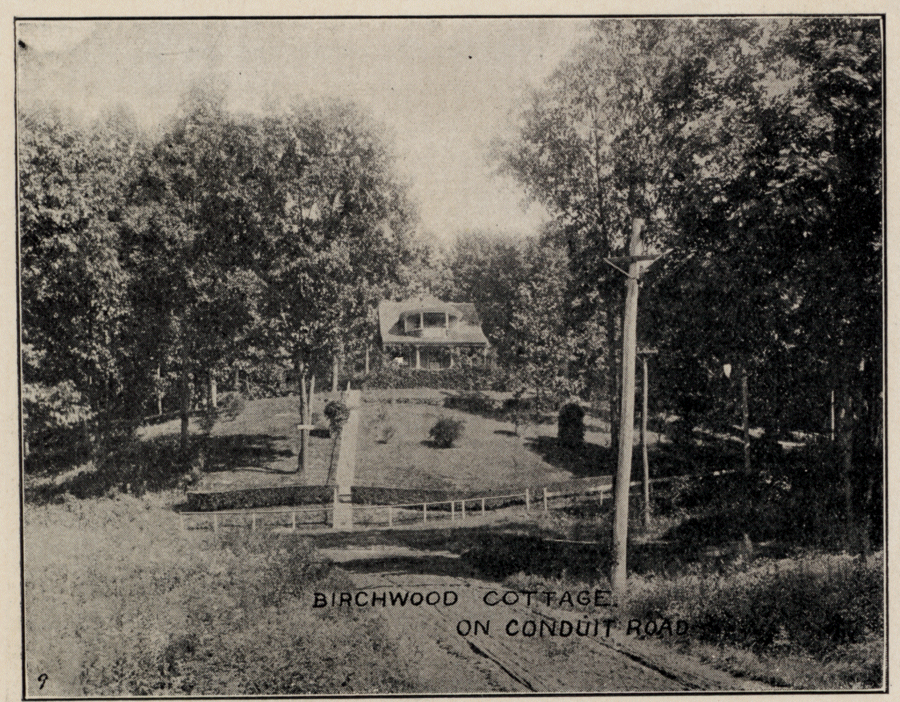
Brichwood Cottage, little is known about this house, 1912
Buildings along Conduit Road
Traveling along Conduit Road, the next building found in the early years was Brichwood Cottage which sits in a narrow valley, perched above the road well up the hillside. Little is known of the cottage's history, the first printed mention of the house was in 1912, when the photo seen here was taken. It is likely that the lot was bought from the Baltzleys as early maps of their lang include the cottage site.
For many years the quaint house sat isolated from other homes, it was after the 1950's that several nearby homes were built.
WHile it is purely speculation, one of the staff members at the Glen Echo Chautauqua was a Mrs, Susie Birch Jennings. Perhaps she was the owner of the cottage.

an aerial view of the Glen Echo Amusement Park, ca 1926
Buildings along Conduit Road
The next structures along the road were those of the glen Echo Chautauqua. After the Chautauqua failed the grounds were used for various entertainments until around 1899 when Glen Echo was turned into an amusement park.
The combination of the trolley line, which had reached the park grounds by 1896, and the wonderfully maintained road, made Glen Echo Amusement Park an instant hit among Washingtonians.
The height of the park above the river and the higher elevation of the land compared to the city tended to make the park cooler than the city, another nice feature to attract visitors.
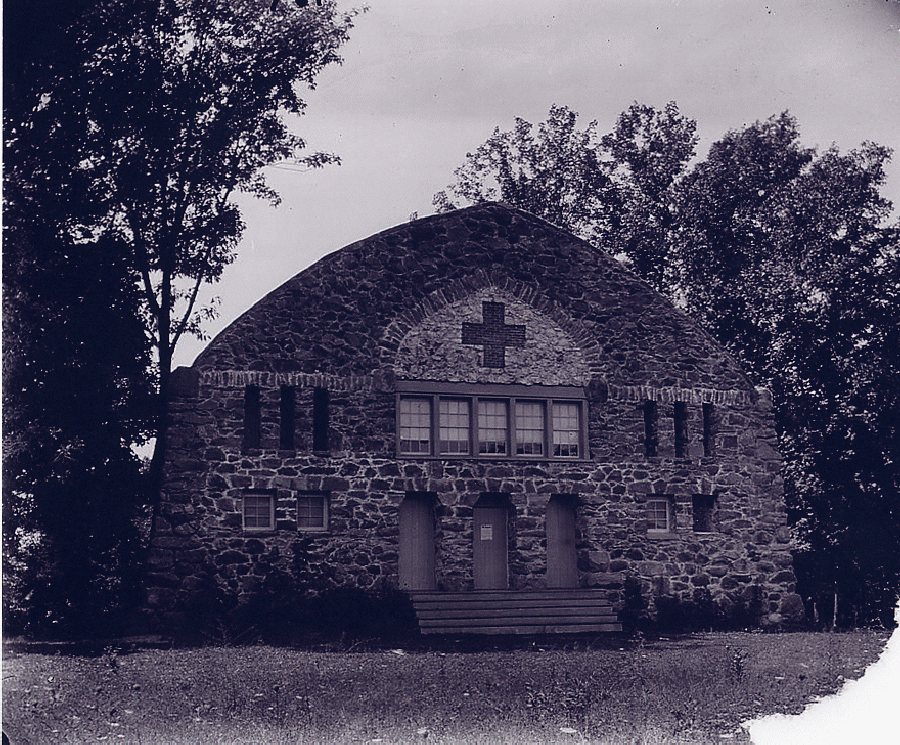
The Red Cross Building, also known as the Clara Barton House, 1896
Buildings along Conduit Road
Abutting the amusement park property sits the Clara Barton House. Barton was the founder of the American Red Cross and came to Glen Echo at the Baltzley's invitation. She was appointed as head of 'The Women's Executive Committee' of the Glen Echo Chautauqua, which had many other promenent women on it.
Clara was also given her choice of building lots, she chose a site that cut across three or four platted lots, but the Baltzleys met her wishes and redivided the land to suit her desires. The transaction was reported to be a sale, nut in fact the Chautauqua bookkeepping records show that she was given the land along with a cash and free labor and materials to build her building.
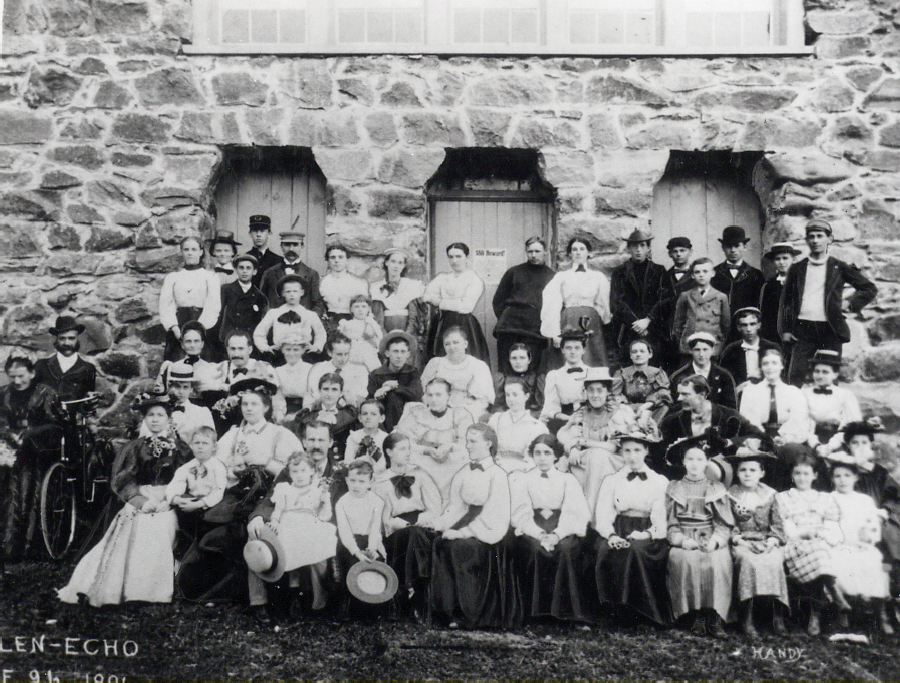
A picnic group out at Glen Echo in 1896, standing in front of the Clara Barton House, in spite of the no trespassing sign on the door.
Buildings along Conduit Road
All of the Chautauqua documents refer to the structure as 'The Red Cross Building'. One early photo is captioned 'Red Cross Chapel', but this is a unique label.
Clara used the building as a warehouse after the Chautauqua failed, until 1897 when she moved into the building and made it her home until her death in 1912.
Clara found the stone facade of the building 'cold and uninviting' and had the center section of the facade torn down, converting the remaining stone portions into two towers flanking the new frame entrance and porch.
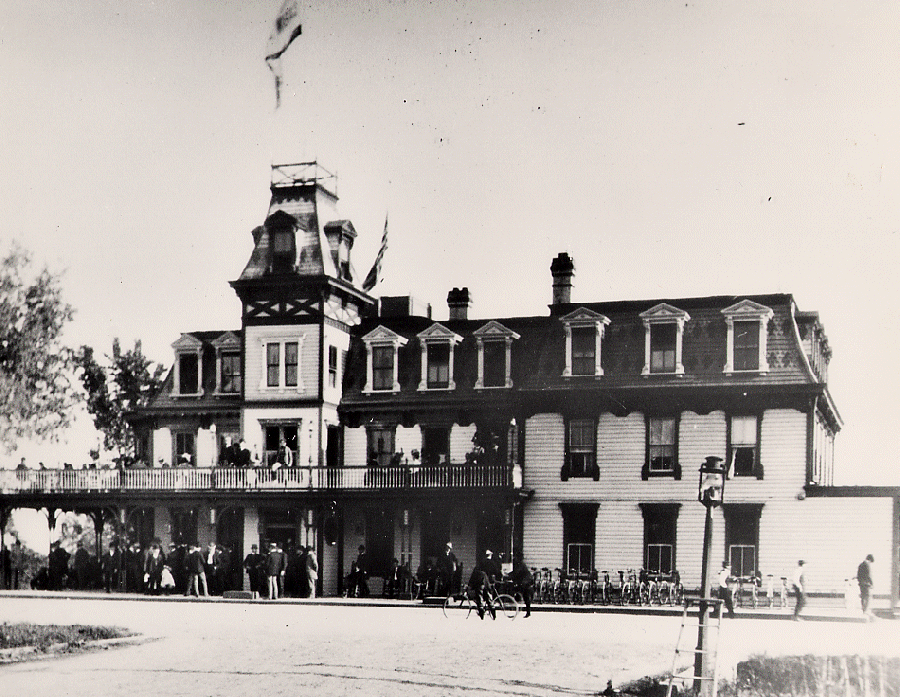
The Cabin John Bridge Hotel with a large group of bicyclers, ca 1900
Buildings along Conduit Road
At the turn of the century, around 1900, there was a considerable gap before coming to the next building. The town of Glen Echo was not chartered until 1904, and though there were a number of homes there by then, most of them sat away from Conduit road.
The next thing you came to was the Cabin John Bridge, crossing the bridge you came to the Cabin John Bridge Hotel.
The front porch of the hotel was connected to the bridge by a very short sidewalk. The hotel was a grand wooden structure, which in later years was painted a creamy yellow, with green shingles. The hotel had formal dining rooms as well as a rathskeller which had a pretty shady reputation.
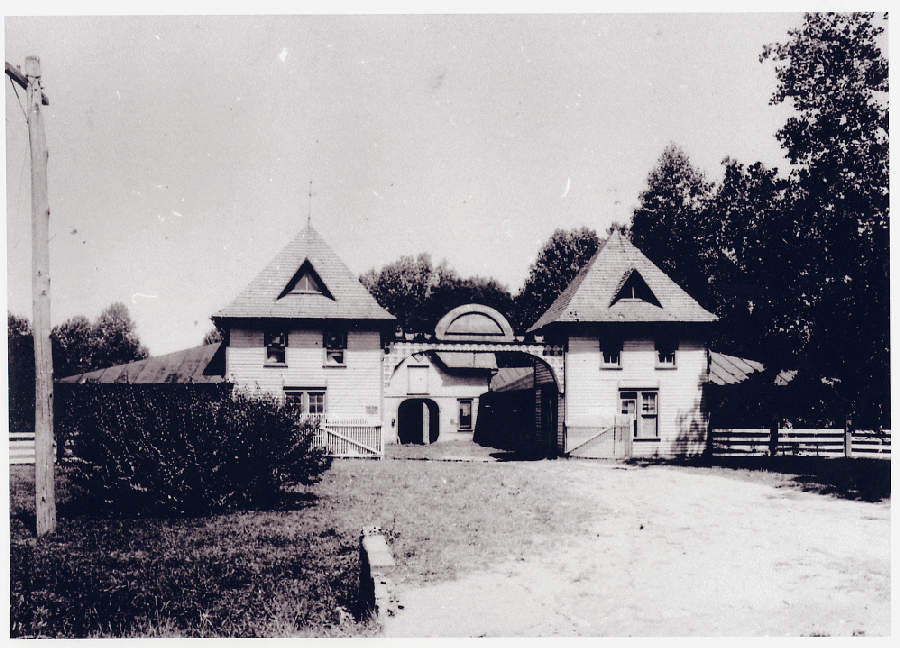
The stables of the Cabin John Hotel, ca 1905
Buildings along Conduit Road
The dining room and rathskeller both sold alcohol, in defiance of the local option laws which made the sale of intoxicating beverages illegal for most of the life of the hotel.
Across the Conduit Road from the hotel sat the hotel's stables, used both for the Bobinger family who lived in and owned the hotel, and for their customers, many of whom came by carriage.
While there were a few more buildings further along the road befor 1912, we will end our journey here.
|
|




